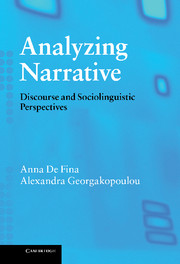Book contents
- Frontmatter
- Contents
- Acknowledgments
- Preface
- Note on transcription conventions
- 1 Narrative definitions, issues and approaches
- 2 Narrative as text and structure
- 3 Narrative and sociocultural variability
- 4 Narrative as interaction
- 5 Narrative power, authority and ownership
- 6 Narrative and identities
- Notes
- References
- Index
2 - Narrative as text and structure
Published online by Cambridge University Press: 05 June 2012
- Frontmatter
- Contents
- Acknowledgments
- Preface
- Note on transcription conventions
- 1 Narrative definitions, issues and approaches
- 2 Narrative as text and structure
- 3 Narrative and sociocultural variability
- 4 Narrative as interaction
- 5 Narrative power, authority and ownership
- 6 Narrative and identities
- Notes
- References
- Index
Summary
Introduction
As we discussed in Chapter 1, narrative is widely held as fundamental in human communication. Not only do speakers use narratives in most communicative activities, but they also seem to hold intuitive assumptions and expectations about what constitutes a (“good”) story. However, the objective characterization of what counts as a story within the stream of discourse, of how it is internally organized and of how it can be separated from the talk surrounding it remains one of the most daunting tasks for linguists and discourse analysts working in the field, a preoccupation that can be traced back to Aristotle’s Poetics. As we saw in Chapter 1, in more recent times, the definition of story units and components has been a central concern for narratology (e.g. Bal 1985; Genette 1980; Prince 1982) and for cognitive theories of text understanding such as story grammars (e.g. Mandler 1982; Mandler and Johnson 1977; Rumelhart 1975, 1980; Thorndyke 1977).The study of narrative structure across cultures and geographic areas has also occupied center stage in research about oral stories and fables in folk traditions (Propp 1968). In this chapter, we single out linguistic approaches to narrative structure that focus on ordinary storytelling and prioritize the linguistic means through which structural organization is achieved. Even though there are certain common guiding assumptions in this kind of inquiry, there have also been clear divergences amongst different perspectives. In the following sections, we will focus on differing conceptualizations of narrative structure within three approaches to narrative that have been particularly influential in linguistics: Labov’s model, ethnopoetics and conversation analysis. We will take each approach separately and discuss its main assumptions and the criteria employed for identifying structural units. We will then assess their strengths and weaknesses and propose questions and avenues for future research. The discussion will highlight the difficulties involved in the definition and identification of narrative units and in keeping a balance between a focus on local phenomena and an interest in possible generalizations about the nature of narrative organization.
Information
- Type
- Chapter
- Information
- Analyzing NarrativeDiscourse and Sociolinguistic Perspectives, pp. 26 - 51Publisher: Cambridge University PressPrint publication year: 2011
Accessibility standard: Unknown
Why this information is here
This section outlines the accessibility features of this content - including support for screen readers, full keyboard navigation and high-contrast display options. This may not be relevant for you.Accessibility Information
- 1
- Cited by
